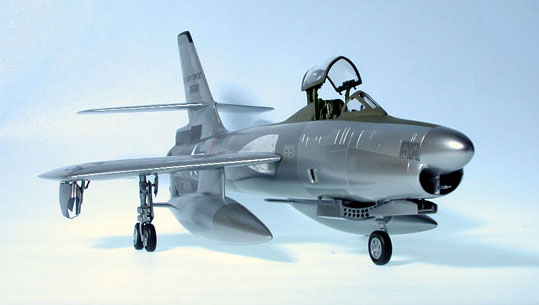|
Republic
XF-91B
Thunderceptor
by
Phil Brandt
|

|
|
Republic
XF-91B Thunderceptor
|
images
by Milton Bell

HyperScale is proudly sponsored by
Squadron
The radical lines of this Fifties interceptor mark the end of
Republic's F-84 design evolution: inversely tapered, variable
incidence wings; outward folding tandem main landing gear; and a
powerful empennage-mounted rocket engine to bolster the thrust of its
J-47 jet engine. Although two XF-91s were built, only one became the
F-86D lookalike B model which was envisioned to meet an Air Force
requirement for a radar interceptor to complement the F-104. The
intended Curtiss-Wright rocket engine never made it into production,
but had it become a reality, Mach 2 speeds were estimated.....in 1952!
Instead, the less powerful, four-chambered rocket engine from the Bell
X-1 was substituted, which still produced level speeds of mach 1.2.
The B model survived testing and is on display at the USAF Museum
where yours truly was able to take a group of closeup pix during one
of his many pilgrimages to Fairborn, Ohio.
Building
the Thunderceptor
|
Although Bondo certainly owns his share of
exceptionally-mastered-but-as-yet-unbuilt Tamiyagawa kits, there's
still a masochistic attraction in his elderly bones to do exotic
airframes, even though it's fer sure a plastic 'beating's' gonna go
along with the project. And so I retrieved my ancient 1/48 Lindberg
XF-91 and F-86D kits, neither of which would make most modeler's Top
1000 list, out of long term storage and began surgery. It's uncanny
how closely the forward fuselage of the XF-91B resembles the Sabre
Dog, but I'm here to tell ya, my nickname was fully borne out when
coat after coat of epoxy/lacquer putty dried, was ground down and
sanded! Especially taxing was the scratchbuilding of the under-radome
intake trunk and the splitter section/nosegear well. One-off B-model
nosegear doors were also scratchbuilt.
After the forward fuselage lines were beaten into submission, the
aft rocket pack extension came in for its own re-profiling. I
lengthened it and scratchbuilt the rocket exhaust outlets. The jet
engine exhaust was kitbashed with a resin aftermarket one for the
Academy Flanker. Just as in the case of the F-86D, a ventral rocket
weapons tray was envisioned by Republic's designers, so I integrated
the deployed tray from one of my two 1964 vintage Marusan 1/50 Sabre
Dog kits.
The Lindberg cockpit could charitably be said to be non-existent,
with a molded-in pilot's upper torso and seatback. I've always liked
the Monogram F-84F, albeit the raised details, and they have a nicely
'busy' cockpit tub, seat, instrument panel and, best of all, the
canopy raising mechanism, with canopy side detailing. I 'Dremmelled'
out the existing Lindberg 'cockpit' and fuselage sides and applied a
thin layer of A&B epoxy putty. Then I pushed the Monogram tub into
place, withdrawing it to leave a perfect mounting impression for the
later tub installation. The instrument panel coaming w/black boxes was
shaped from the same component in the Monogram F-100. The area aft of
the seat and canopy was scratchbuilt, using the F-84F canopy
components integrated with the Lindberg XF-91 profile and the
distinctive XF-91 canopy.

Per modeling custom in the Fifties, Lindberg provides only a gear
door outline on the wing undersides. I cut out the gear doors and
boxed in the wheel well sides, adding Evergreen strips as necessary
for structural detailing. Another set of gear doors was cut out of a
second XF-91 kit, and all door edges were "rabbitted" with
the Dremel to give structural appearance. All wheels were widened with
plastic sheet, discbrake calipers were scratchbuilt and gear mounts
were fabricated within the wheel wells. The nosegear strut was
accurized per my museum pix.
The distinctive external tanks were correctly molded by Lindberg,
but new, more extended pylons were scratchbuilt, incorporating the
downward incidence of the tank tips. A small "point" was
added to the stabilator leading edge where it intersects with the
vertical fin leading edge. This may seem a small thing, but, together
with the serious stab fit problem in the Lindberg kit, occupied
significant building time to fillet, putty and sand to the degree
necessary for a natural metal finish.
The entire airframe was scribed per line drawings I had collected
and enlarged from an old magazine feature.
Many iterations of Blue Acryl, gray lacquer primer, and progressive
sanding took place until the flat primer took on a gloss. Three shades
of my favorite metallizer, Alclad II, were airbrushed, followed by
some darker shades of Testors Metallizer. I always do the Testors on
top of the Alclad because the Testors doesn't like to be masked.
Baremetal foil was applied to the highly polished stainless friction
area where the variable incidence wing rubs against the fuselage.
Decals were minimal and were taken from various SuperScale sheets.
Wash was not applied because as a minimally flown prototype, the bird
was usually in very clean condition. In fact, the B model at the USAF
Museum has been painted with silver lacquer.
It's been a real Dance Plastique, and Bondo probably won't
subject himself to this routine for some time to come.....but then
there's always the Airmodel PSM-6, the Combat Tradewinds and all those
Mach 2 kits!
Phil Brandt IPMS 14091
Model and Text Copyright © 2001 by
Phil Brandt
Images Copyright © 2001 by Milton
Bell
Page Created 30 May, 2001
Last Updated 04 June, 2007
Back to HyperScale Main
Page
Back to Features
Index
|
Home
| What's New |
Features |
Gallery |
Reviews |
Reference |
Forum |
Search